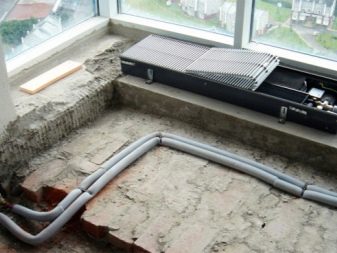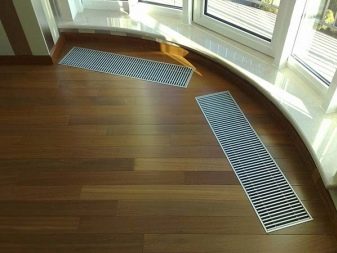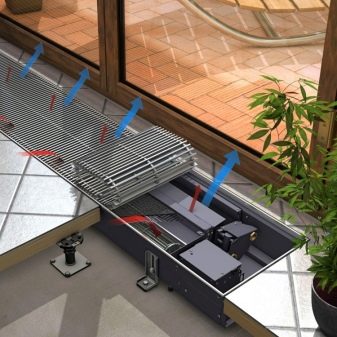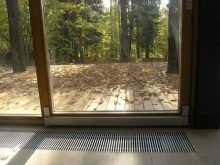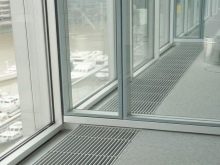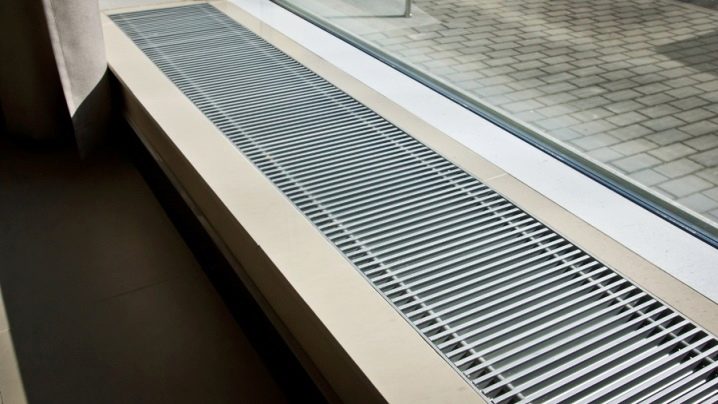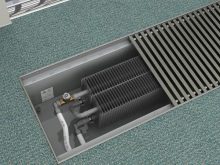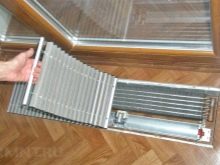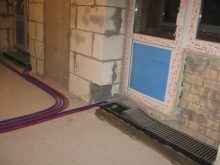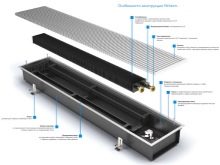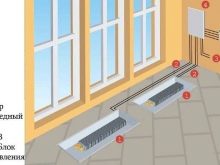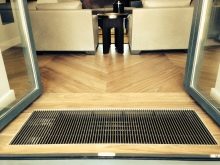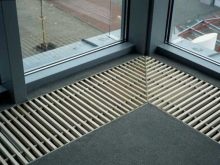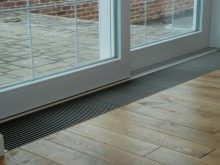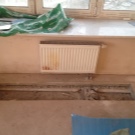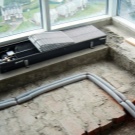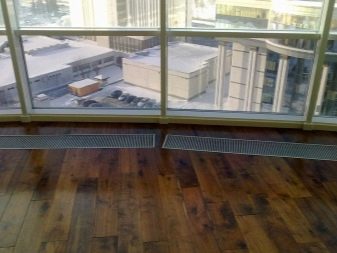Floor-mounted heating radiators: features and subtleties of installation
Floor heating radiators have become very popular lately. They are increasingly used in the arrangement of modern homes. This solution is especially common in large rooms or in rooms with glass walls. These can be, for example, winter gardens, large glazed terraces or trading rooms.
Main characteristics
Floor radiators are heat generating equipment that is installed so that no technical elements are visible. The design of the radiator is quite simple and is a box made of stainless steel. Inside it has heat exchangers consisting of copper and aluminum. To connect floor-mounted radiators, use corrugated tubes made of materials resistant to corrosion.A distinctive feature of the device is that there is no gap between the plates and the contour.
Such designs happen with cases and without them. Both options are fairly simple to install. Before installation, you need to prepare a chute corresponding to the length of the radiator. Then the device itself is placed in it, and only after that the radiator is connected to the communications. The sizes of radiators are from 90 centimeters to three meters. This allows you to choose an option that will fully correspond to the selected room. That is, he will be able to fully warm it, and at the same time will not take up too much space in the room.
Principle of operation
The heating process takes place due to convection; therefore, such structures are called built-in convectors. The principle of operation is as follows: cold air flows through the grate down, and then heats up and rises back. There is a special subspecies of such radiators with fans, where convection heating occurs naturally. They are more effective because they heat the air much faster in the room where they are located.This happens by moving both warm and cold air.
The heating grids themselves can be metal or wooden. They can be painted with paints of different shades. This is done to ensure that the heater organically blends into the interior of any room. For the safety of users, the grids do not get very warm. Their temperature is never above thirty degrees, so there is no possibility to get burned.
The work of the built-in radiator is based on air circulation. Install it near the windows or glass doors. In the radiators placed relief valve, which is connected immediately after installation of the radiator. It helps to clean the airiness of the system, and also significantly increases its efficiency. Regulators located in it, set the desired temperature in the room.
Advantages and disadvantages
Floor constructions have both advantages and disadvantages. Having dealt with all these moments, you can understand what kind of heating is better to choose for a particular room.
Among the advantages of radiators embedded in the floor, it is worth noting the following:
- rather long service life, which will make it possible not to think about repairing or replacing it after installation;
- floor-mounted radiators have a fairly high performance, but the costs are minimal;
- they are reliable, trouble-free and also environmentally friendly;
- floor-mounted radiators are hidden from prying eyes and do not spoil the interior with their appearance. They do not occupy space, so do not interfere with the placement of furniture;
- Such models provide an opportunity to install a panoramic window.
With all these advantages, there are moments that significantly reduce the popularity of these models of radiators.
The disadvantages include the following:
- to install such radiators, it is necessary to increase the height of the ceilings;
- the price of such structures is much higher than that of simple floor or wall models;
- if the ceiling height is more than three meters, then floor-mounted radiators will not work. It is better to purchase wall designs;
- moreover, this kind of radiator is much more difficult to install;
- If the radiator has the function of forced convection, then the charge for electricity will increase significantly. As well as such models contribute to the spread of dust.
Kinds
Floor-mounted radiators can be divided into two types.
- Electric. Such designs have TENY of the closed type where plates are installed. They can be copper or steel. Radiators are manufactured according to all safety requirements of electrical appliances, as well as equipped with fuses to protect against failures. Use such models in those houses where there is no connection to centralized heating.
- Water batteries are a metal tube with plates. Such a radiator is connected to the central heating system with the help of branch pipes. Similar constructions are also made from both copper and aluminum or steel.
Although radiators with copper heaters are quite efficient in terms of heating, they are difficult to use in conditions of centralized heating in apartment buildings.
Recommendations for selection
When buying electric floor radiators for heating, it is imperative to determine what level of power will be needed in the process. And also it is necessary to take into account whether it will be a radiator with forced convection, or a natural function will suffice for this room.
Buying built-in batteries with coolants,Be sure to consider several factors.
- Pressure in the heat system. This option is suitable for homes with a closed heating system. If you need to install floor-mounted radiators in multi-storey buildings, you should immediately look at the level of pressure in the pipes. This is done in order to make sure that the specified level will be enough to heat the room. Data on this issue can be obtained in the housing office. And only after obtaining the necessary information, you can proceed to the selection of a suitable model. Usually for apartment buildings pick up a radiator that can withstand fifteen atmospheres.
- Type of coolant and its parameters. For radiators embedded in the floor in a private house any type of heat carrier will be suitable. After all, the owners of their homes themselves control both its temperature and its condition. But for residents of high-rise buildings, filling radiators is a rather important factor. The wrong choice in this case can create many problems. Therefore, when purchasing such structures, it is necessary to determine the model in advance and pay special attention to quality. Attention should be paid to the level of Ph liquid and the temperature, and the other characteristics of the coolant.
- Connection diameters and type of heating system.The heating system can be one-pipe and two-pipe. Many models of radiators will function normally only when they are connected to a particular system. Therefore, all the necessary information you should definitely find out when buying from sellers.
If the diameters do not match, you can use adapters.
Floor heating radiators are universal in contrast to wall analogues. They can be installed in any room, be it residential or office, or commercial. Floor-mounted heating radiators are also suitable for private homes with French windows. Such radiators would be appropriate for heating shops, galleries, and even for greenhouses. Floor heating radiators are used with great success for rooms with a special microclimate.
When buying such radiators, you should pay attention to models that have the function of condensate drain, which is characterized by convenience in everyday life. All actions of such devices are regulated by an automatic system, which allows you to pre-set the desired temperature mode.
How to install?
Getting to the installation work, you need to correctly calculate not only the power of the equipment, but also the operating pressure in the system.And also there is a possibility that in the place of installation of the floor radiator you will have to make a raised floor. This will slightly change the height of the room, as well as its area. Next, you need to prepare a niche for a floor-mounted radiator. In size, it must comply with the parameters of this design and even slightly exceed them. The niche itself is constructed not in a concrete screed, but in a specially made catwalk. The radiator is fixed with anchor bolts.
If the convector is built under the windows, you should not think about connecting it. After all, it can be both left-handed and right-handed. But installing it at the window, it is necessary that the indent is not less than ten centimeters, and the distance from the walls to the convector is not less than twenty centimeters. Further, the strapping is built into the floor. It is carried out using polypropylene pipes. They are subsequently poured with concrete or cement screed. Therefore, the pipeline is better to use copper.
The connection of the radiator itself can be done using flexible hoses. To make it easier to use the equipment, you can connect an automatic thermostat or even a thermostat.
If we talk about the heating system, the installation of which uses hidden under the floor radiators, it is worth noting that it is considered the most simple in terms of installation. Even a person with a minimum of experience will cope with the installation of such radiators. When doing underfloor water heating, it is imperative to ensure that all energy systems are connected to the right place. All this must be considered in the early stages of design. Otherwise it will be impossible to ensure the normal operation of the entire heating system. The only correct solution in this case is to install an electric convector.
Having decided to install floor-mounted appliances for heating, it is possible to achieve not very expensive and at the same time a full heating of the room. This option will allow you to create a stylish interior in any room. However, prior to installation it is imperative to examine all the features and subtleties of the installation work, which subsequently greatly facilitate the work. Only in this case, the result will be satisfactory.
For the installation of an Itermic floor convector, see the following video.


